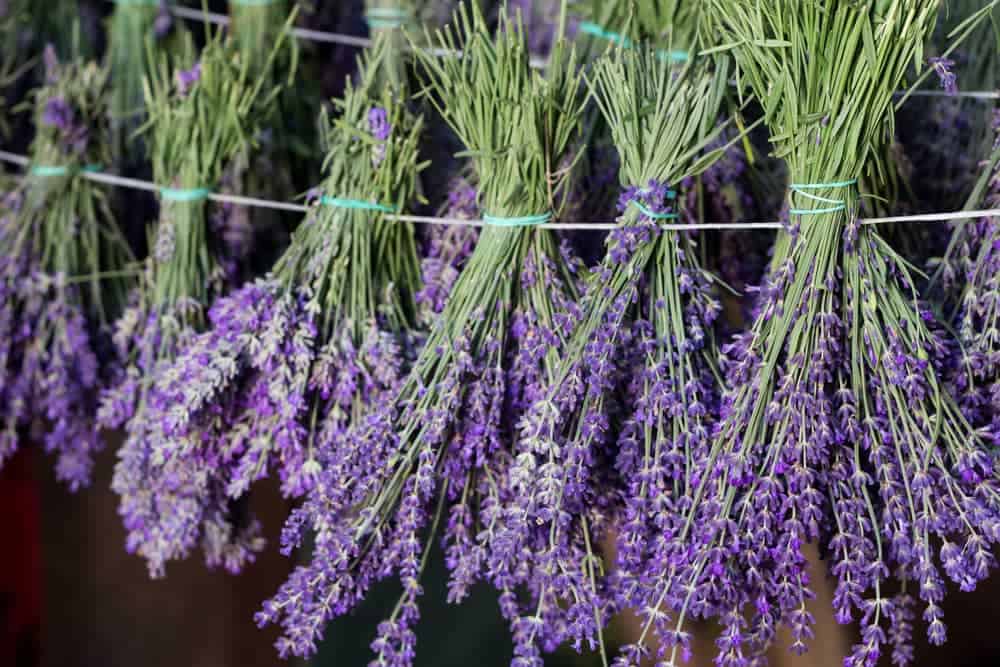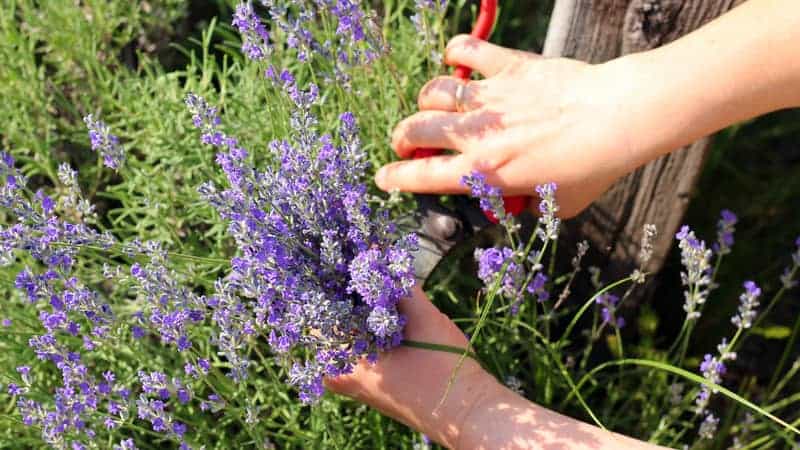There are endless uses for lavender at home – food garnish, interior decor, and essential oils. But one easy use is dried lavender!
A bouquet of dried lavender flowers looks stunning, while lavender potpourri smells heavenly.
Moreover, lavender has many health benefits since it’s soothing and calming. And it makes a space look oh-so homely.
How to dry lavender? First, choose the best variety – ideally English lavender or a French hybrid. Then choose whether you’ll be drying the sprigs, buds, or leaves.
Methods for drying lavender include:
Ready for a pretty bouquet of sweet-smelling buds? Grab a pair of pruners and get ready to cut – it’s time to dry lavender.
Harvesting Lavender
There are some tricks to gathering lavender for drying – you can’t just snip off a sprig at random!
Make sure to time it right, get a clean cut, and use your best varieties.
This way, if you grow lavender yourself, you’ll ensure the health of your plants and the cut stems.
When to harvest lavender for drying
This depends on what you’re planning to work with! It’s essential to harvest from your lavender plant at the right time, as this will retain the most fragrance and structure.
You can harvest the buds (unopened florets), sprigs (opened flowers), or leaves. Harvesting before the buds open will create the longest-lasting fragrance and colour.
- Lavender buds: Pick these before they’re in full bloom, when the florets haven’t opened. The buds will often be bright purple. This is usually in late winter through spring, possibly into early summer.
- Lavender sprigs: Cut lavender flower sprigs after the plant is finished blooming, usually in late summer to autumn.
- Lavender leaves: You can pluck lavender leaves at any time, but ideally after the flowers have bloomed. Use tender, new growth near the stem tips for best results.
If you’re planning to prune lavender, you can use those cuttings for drying fresh lavender! Otherwise, give your regular garden professionals a heads up so they can save some cuttings for you.
As for what time to pick lavender for drying, it’s best done around mid-morning, after the morning dew has evaporated.
You can still dry lavender buds and sprigs during the growing season, but know that they’ll lose their colour and fragrance much faster!
How to cut lavender for drying
For flower buds and stems, you’ll need a sharp pair of precision pruners or secateurs. You can disinfect them with some rubbing alcohol or a quick wash to ensure a clean cut.
If your chosen method is to hang lavender, make the cut right at the base, above the leaves.
On the other hand, if you’ll be oven-drying lavender or exposing it to direct sunlight, cut just below the buds.
For leaves, simply pluck them off the stem!
Best lavender varieties for drying
There are several types of lavender you can grow in Australia, but some are better than others for drying.
If you’re looking to dry lavender flowers or leaves, choose:
- English lavender (Lavandula angustifolia)
- Spanish lavender (Lavandula stoechas)
- French hybrid cultivars
However, you can use any of the lavender varieties and cultivars at your disposal.
How To Dry Lavender Flowers
There are several straightforward options for drying lavender. Once you’ve gathered the buds, sprigs, or leaves, choose which method works best for you!
These methods work for drying lavender leaves as well.
Drying lavender by hanging
One of the simplest ways to dry lavender is by hanging it upside-down. This is best for small bunches with long stems – perfect for making lavender bouquets.
Depending on how humid it is, the drying process may take up to a week or more.
Start by gathering around 10–15 lavender stems with flowers (or more, we won’t stop you!). Secure them together with a string or rubber band.
Hang the lavender bundles in a cool and dry place, away from direct sunlight. Make sure there’s good air circulation in and around the bundles to prevent mould.
If you can, hang the bundles in a dark place for better colour retention.
Check the bundles every few days until they’re completely dry. If the stem breaks easily, with a crisp snap, the lavender is ready.
Drying lavender in the sun
You can also let the lavender dry under the sun, but know that this will bleach the colour to a pale purple. However, it’s quicker than hanging lavender to dry in a dark room.
Lay the flower stems or buds in a single layer on a drying rack or wooden board. Set these outside in the sunlight, or indoors by a window.
(In a pinch, you can also spread the stems over some paper towels on a sill or counter.)
The hot sun will dry out the lavender in around a week, or less if it’s particularly hot. Perform a good air circulation check every other day, and watch out for signs of mould.
Also – keep an eye on your lavender to make sure it doesn’t get blown away or eaten!
Drying lavender in the microwave or oven
How to dry lavender quickly? Turn to your kitchen! You can absolutely dry lavender in the microwave or oven – just pay very close attention so your kitchen doesn’t catch fire.
For the oven, preheat it on the lowest setting. Then simply lay the lavender onto an ungreased baking tray (lined with baking paper) and place it in the oven.
Check every 10 minutes, although the process shouldn’t take more than a few hours. Once the stems are brittle, remove them.
On the other hand, for the microwave, put the lavender in an uncovered microwave-safe container.
Use the medium setting, then set the timer for 1 minute. Check for dryness once it’s done. You can continue in 20-second bursts until the stems have a crisp snap.
Drying lavender in a food dehydrator
This is another quick way to dry lavender at home, and it’s best if you want to use the lavender for infusion. Moreover, it completely dries out the plant, preventing the risk of mould.
Set a dehydrator to its lowest setting (no more than 40ºC or 105ºF). Then lay out the lavender buds or sprigs on the dehydrator trays in a single layer.
The process will take about 24–48 hours, depending on the type and size of lavender. You can pause the cycle and check to see if the plants feel brittle or crumbly to touch.
Transfer the dried lavender to an airtight container for storage.
How To Store Dried Lavender
Lavender needs to be completely dry before storing. The flowers and leaves will feel brittle, and fall off when touched.
Either remove the flower buds by gently running your fingers up the stem, or simply leave them on.
To keep dry lavender for longer, store it in a clear jar or similar airtight container, and place it somewhere cool and dark. Otherwise, display your dry lavender however you like!
Ways to Use Dried Lavender
Dried lavender has plenty of uses, so it’s well worth setting some aside to dry in your free time.
It can keep for months as well, although it will lose its scent after a few weeks – you can refresh the flowers with essential oil.
Lavender sachets
Fill sachets with dried buds and some mint, and presto! Homemade lavender tea. Simply steep the sachet in hot water, then add sugar or simple syrup to taste.
Alternatively, create a homemade potpourri with dried lavender mixed with other flowers and herbs.
Fill up large sachets or sisal pouches with the potpourri and place them in rooms to release a gorgeous scent.
Dried lavender bundles
Dried flowers are a popular indoor accent, and lavender plants are no different. Simply gather a bunch of lavender and tie it with some ribbon or raffia.
Display the dried flowers in a clear vase for the most impact.
Bath products
Lavender is great for DIY bath bombs or bath salts!
Combine your dried lavender with baking soda, citric acid, Epsom salt, cornstarch, coconut oil, and water.
Add some lavender essential oil for extra oomph and you’re good to go.
BTW – enhance your bath experience by scattering more dried flowers in the water.
Food garnish
Dried English and Portuguese lavender are often used in the kitchen, whether as garnish or as herbs.
You can sprinkle dried buds onto salads and other dishes, or cook the flowers into a simple syrup.
(Pro tip – if you’re of age, lavender syrup is excellent in cocktails!)
Caring For Fresh Lavender
If you’re planning to grow lavender, it’s very low-maintenance. Lavender is drought-tolerant and will manage by itself.
The most important part of lavender care is pruning, since it encourages healthy growth and lush flowers.
You can also propagate lavender pretty easily, meaning more plants to love!
When it comes to how to dry lavender, the key is not to cut too much. Leave some flowers to bloom and keep the plant growing.
Then you’ll get to enjoy both fresh lavender and dried lavender buds – the best of both worlds.







